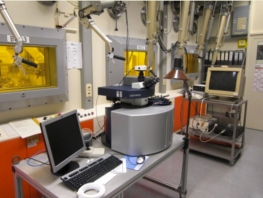STATE OF THE ART
Since the 3rd EURATOM Framework Programme (FP), a series of projects investigated the RN release from spent nuclear fuel. However, most of the published data on fast/instant release fractions (and also on the matrix dissolution) relates to fuel with burn-up values below 45 GWd/tU.
In the past 6
th FP, the
MICADO and
NF-Pro projects mainly focused their work on the relatively slow release in association with spent fuel matrix dissolution. However, with respect to the fast / instant release of radionuclides from spent nuclear fuel elements under deep underground repository conditions, a series of questions remain open after their finalization. These questions concern key input data to safety analysis, such as “instant
release fraction (IRF)” values of some radionuclides that are still largely unknown. Particular importance is referred to the following needs (extracted from the final report of
MICADO) and open issues which define the expected progress beyond the state of the art to be achieved with the FIRST-nuclides project:
-
Improvements in the understanding of the distribution of fission gas release (FGR) for reactor fuels in order to provide more realistic relationships between FGR and release of various fission products, in particular 129I, 79Se and 135Cs for the relevant burn-up ranges.
-
Relationships between the FGR and iodine release for LWR fuel and IRF values of 129I, 14C and 36Cl.
-
Quantification and modelling of long-term retention of fission products on grain boundaries.
-
Quantification of the IRF for high burn-up fuel.
-
Chemical speciation of the relevant elements. In particular, it is unclear in which chemical form and compound 14C is present after its formation and in which stable forms the 14C compounds could convert.

© KIT-INE, 2012
Moreover, in the recent publication of Johnson et al. [1], it has been provided new data on short-term release of
137Cs and
129I for a number of fuels irradiated to burn-ups of 50–75 MWd/kgU. In addition a method for analysis of leaching solutions for
79Se was also developed. The following conclusions and main inputs have been extracted from this work:
-
Ratio of fractional release to FGR to 137Cs was in the range of the previously reports (3:1).
-
129I release was in the order of FGR.
-
Increased power ratings resulted in higher releases of FG, Cs and I.
-
Importance of power history of fuel rods was mentioned.
-
Unclear contribution of the rim region (FG and 137Cs / 129I accumulation) was discussed.
-
Unclear contribution of grain boundary release was observed.
-
79Se was found below the detection limit of ICP-MS methods indicating no preferential release.
-
Fuel sample preparation had significant impact on the results: fragments resulted in higher releases.
-
Presence of cladding lead to an underestimation of the rapid release fraction.
The project FIRST-Nuclide will also respond to these open questions.
[1] Johnson, L., Günther-Leopold, I., Kobler Waldis, J., Linder, H.P., Low, J., Cui, D., Ekeroth, E., Spahiu, K., Evins, L.Z. (2012). Rapid aqueous release of fission products from high burn-up LWR fuel: Experimental results and correlations with fission gas release. Journal of Nuclear Materials, 420, 54-62.